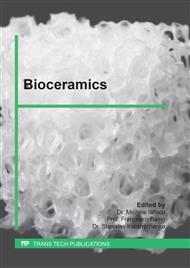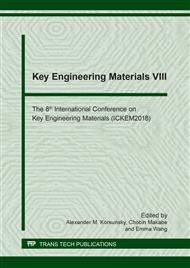[1]
M. Ni, BD. Ratner, Nacre surface transformation to hydroxyapatite in a phosphate buffer solution, Biomaterials 24 (2003) 4323-31.
DOI: 10.1016/s0142-9612(03)00236-9
Google Scholar
[2]
K. Thunsiri, S. Udomsom, W. Wattanutchariya, Characteristic of pore structure and cells growth on the various ratio of silk fibroin and hydroxyapatite in Chitosan base scaffold, KEM 675-676 (2016) 459-462.
DOI: 10.4028/www.scientific.net/kem.675-676.459
Google Scholar
[3]
W. Wattanutchariya, K. Thunsiri, Effects of Fibroin Treatments on Physical and Biological Properties of Chitosan/Hydroxyapatite/Fibroin Bone's Scaffold, AMM 799-800 (2015) 488-492.
DOI: 10.4028/www.scientific.net/amm.799-800.488
Google Scholar
[4]
S. Hirano, H. Tsuchida, N. Nagao, N-acetylation in chitosan and the rate of its enzymic hydrolysis, Biomaterials 10 (1989) 574-576.
DOI: 10.1016/0142-9612(89)90066-5
Google Scholar
[5]
JX. Lu, F. Prudhommeaux, A. Meunier, L. Sedel, G. Guillemin, Effects of chitosan on rat knee cartilages. Biomaterials 20 (1999) 1937-(1944).
DOI: 10.1016/s0142-9612(99)00097-6
Google Scholar
[6]
O. Felt, A. Carrel, P. Baehni, P. Buri, R. Gurny, Chitosan as tear substitute: a wetting agent endowed with antimicrobial efficacy. J Ocul Pharmacol Ther 16 (2000) 261-272.
DOI: 10.1089/jop.2000.16.261
Google Scholar
[7]
GJ. Tsai, WH. Su, Antibacterial activity of shrimp chitosan against Escherichia coli. J Food Prot 62 (1999) 239-243.
DOI: 10.4315/0362-028x-62.3.239
Google Scholar
[8]
TL. Liu, JC. Miao, WH. Sheng, YF. Xie, Q. Huang, YB. Shan, J. Yang, Cytocompatibility of regenerated silk fibroin film: a medical biomaterial applicable to wound healing. J Zhejiang Univ Sci B 11 (2010) 10-16.
DOI: 10.1631/jzus.b0900163
Google Scholar
[9]
D. Bellucci, A. Sola, M. Gazzarri, F. Chiellini, V. Cannillo, A new hydroxyapatite-based biocomposite for bone replacement. Mater Sci Eng C Mater Biol Appl 33 (2013) 1091-1101.
DOI: 10.1016/j.msec.2012.11.038
Google Scholar
[10]
SV. Madihally, HW. Matthew, Porous chitosan scaffolds for tissue engineering. Biomaterials 20 (1999) 1133-1142.
DOI: 10.1016/s0142-9612(99)00011-3
Google Scholar
[11]
T. Damrongrungruang, J. Suwannakoot, S. Maensiri, Study of fibroblast adhesion on RGD-modified electrospun Thai silk fibroin nanofiber for scaffold material in Dentistry: A preliminary study. KDJ 12 (2010) 3-14.
Google Scholar
[12]
T. Ikeda, K. Ikeda, K. Yamamoto, H. Ishizaki, Y. Yoshizawa, K. Yanagiguchi, S. Yamada, Y. Hayashi, Fabrication and characteristics of chitosan sponge as a tissue engineering scaffold. Biomed Res Int (2014).
DOI: 10.1155/2014/786892
Google Scholar
[13]
Z. Izadifar, X. Chen, W. Kulyk, Strategic design and fabrication of engineered scaffolds for articular cartilage repair. J Funct Biomater 3 (2012) 799-838.
DOI: 10.3390/jfb3040799
Google Scholar
[14]
Z. Peng, Z. Peng, Y. Shen, Fabrication and Properties of Gelatin/Chitosan Composite Hydrogel. Polym Plast Technol Eng 50 (2011) 1160-1164.
DOI: 10.1080/03602559.2011.574670
Google Scholar
[15]
M. Dash, F. Chiellini, R.M. Ottenbrite, E. Chiellini, Chitosan—A versatile semi-synthetic polymer in biomedical applications. Prog Polym Sci 36 (2011) 981-1014.
DOI: 10.1016/j.progpolymsci.2011.02.001
Google Scholar
[16]
M. Alizadeh, F. Abbasi, AB. Khoshfetrat, H. Ghaleh, Microstructure and characteristic properties of gelatin/chitosan scaffold prepared by a combined freeze-drying/leaching method. Mater Sci and Eng C 33 (2013) 3958-3967.
DOI: 10.1016/j.msec.2013.05.039
Google Scholar
[17]
F. Croisier, C. Jérôme, Chitosan-based biomaterials for tissue engineering. Eur Polym J 49 (2013) 780-792.
DOI: 10.1016/j.eurpolymj.2012.12.009
Google Scholar
[18]
W. Wattanutchariya, A. Oonjai, K. Thunsiri, Effects of Hydroxyapatite/Silk Fibroin/Chitosan Ratio on Physical Properties of Scaffold for Tissue Engineering Application. Mater Sci Forum 872 (2016) 261-265.
DOI: 10.4028/www.scientific.net/msf.872.261
Google Scholar



